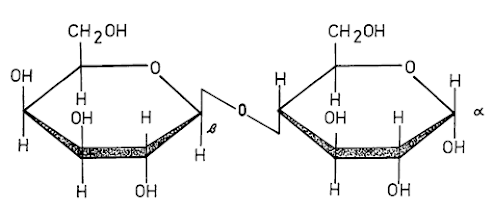Lactose is a naturally occurring carbohydrate found in mammalian milk, including cow's milk and other dairy foods. Lactose biosynthesis takes place in the mammary gland. Concentrations in milk vary strongly with species. It is known as milk sugar. Lactose content of cow milk is 4.9 percent.
Lactose is composed of glucose and galactose, two simpler sugars used as energy directly by human body. Galactose and glucose are linked by a β-L-4 glycosidic bond. Its systematic name is β-0-D-galactopyranosyl-(1–4)- α-D-glucopyranose (α-lactose) or β-0-D-galactopyranosyl-(1–4)-β-D-glucopyranose (β-lactose).
It is normally broken down or digested by an enzyme in human body called lactase and ends up in the bloodstream as glucose (a simple sugar). Lactase splits lactose into glucose and galactose.
Lactose is readily fermented by the lactic acid fermenting bacteria producing lactic acid and has significance in milk and milk products.
Lactose in solid form can either be in a crystalline state or in an amorphous state. Crystalline lactose can exist in a number of distinct forms. Most well-known are α-lactose monohydrate and β-lactose. β- form is more soluble than the α form in water.
Lactose is more soluble in molar solutions of calcium chloride or of calcium nitrate than in pure water. Increase in the concentration of salt brings further increase in the solubility of lactose.
Neither α-lactose hydrate nor β-lactose is hygroscopic. However, anhydrous α-lactose is strongly hygroscopic and can absorb moisture from the air, forming the hydrate that occupies more volume than the anhydrous form.
Lactose is not digested until it reaches the small intestine, where the hydrolytic enzyme lactase is located. Lactase (β-galactosidase), which is located in brush border epithelial cells of the small intestine, catalyzes the hydrolysis of lactose into its constituent monosaccharides. Only monosaccharides among the carbohydrates are absorbed from the intestines.
For people who are lactose intolerant, the lactose doesn’t get broken down. Instead, it goes on to the colon, where it mixes with normal bacteria and ferments. It can cause things like gas, bloating and diarrhea.
Lactose may play a role in the absorption of calcium and other minerals such as copper and zinc, especially during infancy. Moreover, if it is not digested in the small intestine, lactose may be used by the intestinal microbiota (the microorganism population that lives in the digestive tract) as a nutrient (prebiotic).
Properties of lactose
The primary goal of food is to promote our health and general well-being. Food science entails comprehending the characteristics, composition, and behaviors of food constituents in different situations, such as storage, handling, and consumption.
The Most Popular Posts
-
Crude fiber is a measure of the quantity of indigestible cellulose, pentosans, lignin, and other components of this type in present foods. ...
-
Crude fat is the term used to refer to the crude mixture of fat-soluble material present in a sample. Crude fat also known as the ether ext...
-
Gelatinization occurs when starch granules are heated in a liquid. It is responsible for the thickening of food systems. The process is an i...
-
Of the many foods obtained from the land, humans tend to prefer animal foods, mainly beef, pork, poultry and mutton as well as their by-pr...
-
Ash or mineral content is the portion of the food or any organic material that remains after it is burned at very high temperatures. The a...
-
-
-
Most American today are overfed yet undernourished, which eventually leads to obesity and poor health. The answer to those pervasive problem is simply to ...






